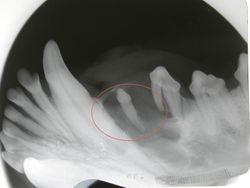Pet Dentistry
Why Have My Pet’s Teeth Professionally Cleaned?
Did you know that about 85% of dogs and cats have some form of periodontal disease? Proper dental care is critical to a pet’s overall good health. If oral infection such as periodontal disease is left untreated, bacteria can travel through the bloodstream and damage internal organs. Animals can suffer the same kinds of dental problems as humans, including infection, severe pain, and fractured teeth.
Periodontal Disease Warning Signs Include:
Bad breath
Tartar (yellow) buildup on the teeth
Swollen, receding, or bleeding gums
Changes in eating habits
Excessive drooling
Fractured or abscessed teeth
Dental Preventative Care

Dental care for animals is similar to dental care for humans, only animals can’t brush their own teeth. To prevent dental problems, follow these guidelines for optimal oral care.
Brush your pet’s teeth daily using specially formulated toothpaste. Do not use toothpaste formulated for humans.
Rinse your pet’s mouth with C.E.T. Oral Hygiene Rinse to help maintain oral health and reduce plaque.
Give a dental treat, such as C.E.T. Chews. When given daily, it will help break down plaque and tartar.
Schedule a regular professional teeth cleaning at St. Francis Pet Clinic
Based on the veterinarian’s dental examination findings, she will recommend a time frame to complete your pet’s dental cleaning. We will remove the plaque and tartar from the teeth and also below the gum line, where non-anesthetic dentals cannot reach, and prepare your pet for at home dental care.
There are various grades of dental disease that are determined by the health of the gums, the amount of tartar on the teeth, and whether any teeth are loose or fractured.
Grade I (Mild) Dental Disease
Grade II (Moderate) Dental Disease
Grade III (Severe) Dental Disease
All Dental Cleanings will receive the following:
A physical examination
Pre-Anesthesia Blood Screen
IV Catheter & IV Fluids
Injectable Sedation, Injectable Anesthesia & Gas Anesthesia Maintenance
Pulse Oximetry, Heart Rate & Respiration Monitoring
Scaling & Polishing Treatment
Hospitalization & Anesthetic Recovery
Hand Prepared Discharge Sheet & Personal Discharge with your pet’s technician
*Extractions are not included in routine dental cleaning estimates and are based on the length of time the extraction(s) take the veterinarian.
Dental X-rays
 Dental X-Rays help us view and treat teeth and bone that is hidden under the gum line.
Dental X-Rays help us view and treat teeth and bone that is hidden under the gum line.
Examining a pet’s mouth can be compared to a wrapped present. You may be able to guess what’s inside by looking at the box, but until you open it, you’ll never know what’s within.
Dental X-Rays allow your veterinarian to examine teeth, bone and the supporting structures below the gum line. They often reveal hidden and painful conditions that would otherwise go unnoticed.
When is it time to take a Dental X-Ray?
When a tooth is loose
When a tooth is fractured (either enamel, dentin, or pulpal exposure)
When a tooth is discolored
When teeth are missing without explanation
When a feline ondoclastic resportive lesion (FORL) is present
When oral or facial swelling is present




